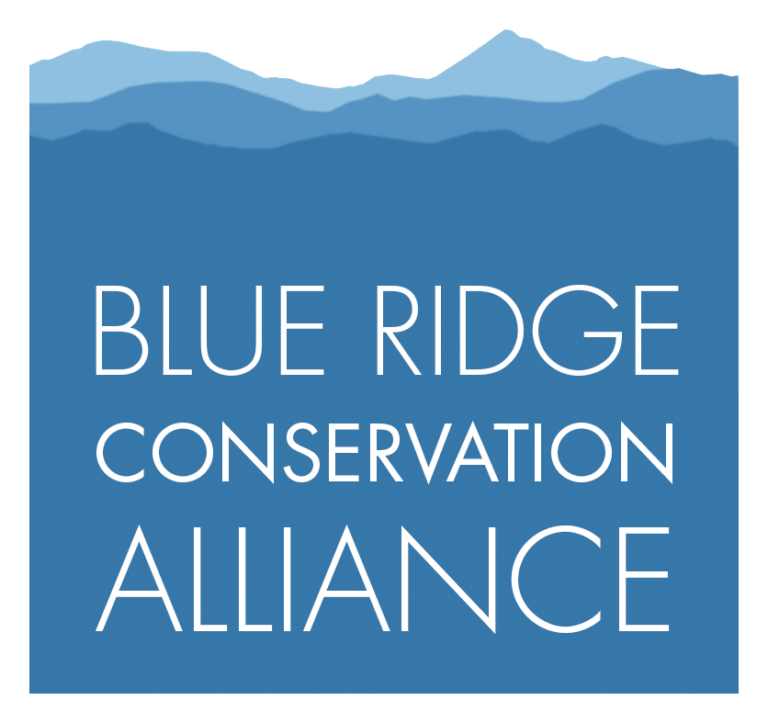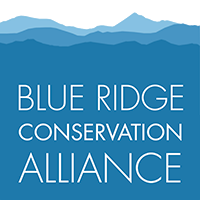Minimize Man-Made Hazards to Wildlife on Your Property
Volume 25 Issue 3, Summer 2020
by Anne Owen, Audubon at Home Program Coordinator
As well as encouraging property owners to provide the essential elements of healthy habitat — native plants, water, and shelter — Audubon at Home also recommends checking for any man-made hazards that could harm the very critters that we hope to encourage coming into our outdoor spaces. Take the quiz to see how critter-friendly your yard is.
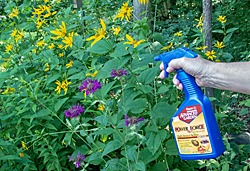
Pesticides, even those “targeted” to particular pests, essentially will kill whatever insects they come into contact with. Photo by Anne Owen
1. Do you use pesticides?
2. Do you use poison or glue traps for rodents out-of-doors?
3. Could there be lead on your property — e.g., from items used for hunting or fishing?
4. Do you let domestic cats outdoors?
5. Could your windows cause bird-strikes?
6. Do you leave outdoor lights on at night?
If you answered “yes” to any of these questions, please read on to find out more.
Pesticides. Overuse and misuse of pesticides, even so-called organic pesticides, is a major cause of the precipitous decline in insect biomass around the world. There is no such thing as a pesticide that is specific to mosquitoes or ticks, or any other perceived nuisance. When we spray pesticides they will to a greater or lesser extent kill whatever insects they come into contact with — and insects fulfill several critical roles in the ecosystem, including pollination, decomposition of organic matter, and moving energy up the food-chain by eating plants, then becoming meals for other critters. These references from the Habitat Network provide suggestions for alternative approaches for ticks and mosquitoes:
“Managing Yards and Green Spaces to Minimize Tick Populations.”
“Discouraging Mosquitoes While Still Providing Habitat for Other Wildlife.”
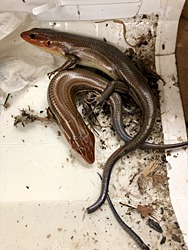
A glue trap intended for rodents instead traps these Five Lined Skinks. Photo by Blue Ridge Wildlife Center
Outdoor poison or glue traps for rodents. Both of these can result in collateral damage, and neither can be considered particularly humane, as both approaches lead to a slow death. The carcasses of poisoned rodents can contain residues that are lethal for hawks, owls, and other animals that consume them. Many creatures other than target rodents can and do get stuck on glue traps, from snakes and amphibians to small birds and desirable mammals like shrews. Find out more about safe rodent control strategies by clicking here.
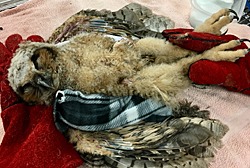
This Great Horned Owl fledgling was poisoned by eating a poisoned rodent. Photo by Blue Ridge Wildlife Center
Lead. Lead gets into the environment through shot and fishing weights. The Blue Ridge Wildlife Center reports that over 80% of the scavenging patients they admit (for example, eagles, vultures, and opossums) are poisoned with lead. To reduce the risks to wildlife, switch to non-lead ammo and fishing tackle. Find out more with this Fact Sheet from The Wildlife Society.
Cats. Domestic cats make wonderful pets, but they are a non-native and potentially invasive species. Outside the home, they become highly efficient, indiscriminate predators of birds, small mammals, and other critters. The American Bird Conservancy estimates that cats kill some 2.4 billion birds each year in the United States alone. We strongly recommend that cats be kept indoors. This is always an emotive topic, but please take the time to read this study, “The Impact of Free-ranging Domestic Cats on Wildlife of the United States.”
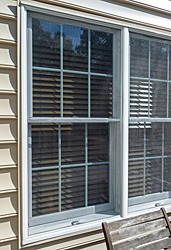
Bug screens and closed blinds minimize the risk of bird collision. Photo by Anne Owen
Window Collisions. Every day at least one million birds are killed in window strikes in the USA, according to a 2014 study. Birds may see a reflection of habitat or see through a window to house plants or vegetation on the other side, then strike the solid glass, trying to reach what they see. Reduce the risk by leaving external bug screens in place year-round and keeping slatted blinds half-closed. The Cornell Lab has a number of other low-cost solutions available at this link.
Outdoor lights. Artificial lights are problematic for both insects and migrating birds. Many species of birds migrate at night, following visual cues from the moon, stars, and the setting sun. Artificial lights draw them in and then they hesitate to leave. Birds have been observed trapped in the beams of floodlights and lighthouses, flying until exhausted. About half of all insect species are nocturnal, and many are attracted to lights, mistaking them for the moon. About one third of insects trapped in the orbit of a light die before morning, either of exhaustion or predation. Artificial lights also affect mating signals, navigation, foraging, and the development of juveniles, according to various studies. The solution is simple — turn off outdoor lighting whenever possible. More information:
Birds and Project Lights Out
Insects and Light Pollution
With awareness and a little effort we can significantly reduce the impact of man-made hazards. Thank you for going the extra mile to protect wildlife in Loudoun County.
The post Minimize Man-Made Hazards to Wildlife on Your Property appeared first on Loudoun Wildlife Conservancy.
The post Minimize Man-Made Hazards to Wildlife on Your Property appeared first on Loudoun Wildlife Conservancy.
